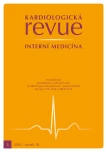Project MedPed – spotlight on patients with familial hypercholesterolaemia
Authors:
M. Vaclová 1; M. Vráblík 1; T. Freiberger 2; R. Češka 1
Authors‘ workplace:
III. interní klinika 1. LF UK a VFN v Praze
1; Genetická laboratoř, Centrum kardiovaskulární a transplantační chirurgie, Brno
2
Published in:
Kardiol Rev Int Med 2016, 18(3): 203-207
Overview
Familial hypercholesterolaemia is an inborn defect of cholesterol metabolism, which seems to be considerably more prevalent than previously thought. Given the recently proposed prevalence of 1: 250 in the general population, we estimate up to some 40,000 individuals are affected in the Czech Republic. FH patients should be diagnosed, adequately informed and treated as early as possible. Comprising of a number of specialised outpatient centres, the MedPed network has been successfully working to this objective for the last 17 years.
Keywords:
MedPed – familial hypercholesterolaemia – cascade screening – cardiovascular risk – mutation – ScreenPro FH
Sources
1. World Health Organization: Familial hypercholesterolemia – report of a second WHO Consultation. Geneva, Switzerland: World Health Or- ganization 1999 (WHO publication No. WHO/HGN/ /FH/CONS/99.2). Available from: http: //apps.who.int/iris/bitstream/10665/66346/1/ WHO_HGN_ FH_CONS_99.2.pdf.
2. Goldstein JL, Brown MS. Familial hypercholesterolemia: identification of a defect in the regulation of 3-hydroxy-3-metylglutaryl coenzyme A reductase aktivity associated with overproduction of cholesterol. Proc Natl Acad Sci USA 1973; 70: 2804–2808.
3. Benn M, Watts GF, Tybjaerg-Hansen A et al. Familial hypercholesterolemia in the danish general population: prevalence, coronary artery disease, and cholesterol-lowering medication. J Clin Endocrinol Metab 2012; 97: 3956–3964. doi: 10.1210/jc.2012–1563.
4. Sjouke B, Kusters DM, Kindt I et al. Homozygous autosomal dominant hypercholesterolemia in the Netherlands: prevalence, genotype-fenotype relationship, and clinical outcome. Eur Heart J 2015; 36: 560–565. doi: 10.1093/eurheartj/ehu058.
5. Delport R. Familial hypercholesterolaemia in South Africans: tracking findings and developments over time – with reference to: prevalence of hypercholesterolaemia in young Afrikaners with myocardial infarction. Ischaemic heart disease risk factors. Cardiovasc J Afr 2009; 20: 18–22.
6. Simard LR, Viel J, Lambert M et al. The Delta >15 Kb deletion French Canadian founder mutation in familial hypercholesterolemia: rapid polymerase chain reaction-based diagnostic assay and prevalence in Quebec. Clin Genet 2004; 65: 202–208.
7. Fahed AC, Safa RM, Haddad FF et al. Homozygous familial hypercholesterolemia in Lebanon: a genotype/phenotype correlation. Mol Genet Metab 2011; 102: 181–188. doi: 10.1016/j.ymgme.2010.11.006.
8. Nordestgaard BG, Chapman MJ, Humphries SE et al. Familial hypercholesterolaemia is underdiagnosed and undertreated in the general population: guidance for clinicians to prevent coronary heart disease: consensus statement of the European Atherosclerosis Society. Eur Heart J 2013; 34: 3478–3490. doi: 10.1093/eurheartj/eht273.
9. Williams RR, Hunt SC, Schumacher MC at al. Diagnosing heterozygous familial hypercholesterolemia using new practical criteria validated by molecular genetics. Am J Cardiol 1993, 72: 171–176.
10. Identification and Management of Familial Hypercholesterolaemia (FH). NICE Clinical Guidelines, No. 71. National Collaborating Centre for Primary Care (UK). London: Royal College of General Practitioners (UK) 2008.
11. van Aalst-Cohen ES, Jansen AC, Tanck MW et al. Diagnosing familial hypercholesterolaemia: the relevance of genetic testing. Eur Heart J 2006; 27: 2240–2246. doi: 10.1093/eurheartj/ehl113.
12. Varret M, Abifadel M, Rabès JP et al. Genetic heterogeneity of autosomal dominant hypercholsterolemia. Clin Genet 2008; 73: 1–13. doi: 10.1111/j.1399-0004.2007.00915.x
13. Rader DJ, Cohen J, Hobbs HH. Monogenic hypercholesterolemia: new insights in pathogenesis and treatment. J Clin Invest 2003; 111: 1795–1803. doi: 10.1172/JCI20031892.
Labels
Paediatric cardiology Internal medicine Cardiac surgery CardiologyArticle was published in
Cardiology Review

2016 Issue 3
Most read in this issue
- Beta-blockers with the smallest negative impact on cardiorespiratory fitness in healthy people
- Endovascular treatment of iliofemoral deep venous thrombosis
- Possibilities of endovascular treatment of acute limb ischaemia
- Type B aortic dissection with severe visceral and limb ischaemia treated with a complete endovascular revascularisation – a case report
